CCNP SWITCH Final Exam Answers – Version 7.1
1. Refer to the exhibit. Based on the provided show ip dhcp snooping command, which statement is true?
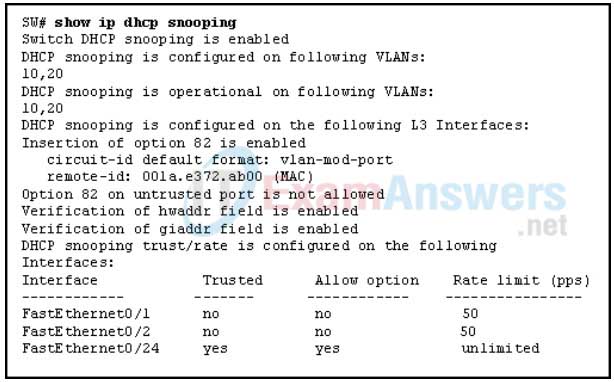
- Only port Fa0/24 can send and receive all DHCP messages.
- Ports Fa0/1, Fa0/2, and Fa0/24 can send and receive all DHCP messages.
- Only ports Fa0/1 and Fa0/2 can send and receive all DHCP messages.
- Ports Fa0/1, Fa0/2, and Fa0/24 can send and receive only DHCP requests.
2. Refer to the exhibit. Which feature is configured in the displayed output?

- Nonstop Forwarding (NSF) with Stateful Switchover (SSO)
- Route Processor Redundancy Plus (RPR+)
- Route Processor Redundancy (RPR)
- Stateful Switchover (SSO)
- Bidirectional Forwarding Detection (BFD)
- Virtual Switching System (VSS)
3. What device can be used to support Power over Ethernet (PoE) to power the access points?
- a host computer
- an IP phone
- an Ethernet switch
- a lightweight access point
4. Which three actions are taken when the command switchport host is entered on a switch port? (Choose three.)
- BPDU guard is enabled.
- Cisco Discovery Protocol (CDP) is disabled.
- VLAN trunking protocol (VTP) is disabled.
- PortFast is enabled.
- Trunking is disabled.
- Channel group is disabled.
5. Which statement is true concerning the core layer within the hierarchical design model?
- Remote users are granted access to the network through the core.
- Routing should be configured without traffic filtering, address translation, or other packet manipulation at the core.
- The core, which acts as the front door to a network, is designed to prevent unauthorized users from gaining entry.
- The core provides an optimized and reliable transport structure by using a combination of route summaries, distribution lists, and route maps.
6. Which two items in the TCAM table are referenced in the process of forwarding a packet? (Choose two.)
- VLAN ID
- ACL information
- destination MAC address
- QoS information
- source MAC address
- hash key
7. Which three steps are required to configure interfaces as routed ports on a multilayer Catalyst switch? (Choose three.)
- Enable IP routing globally.
- Assign IP addresses to routed ports.
- Configure SVI for each VLAN in the network.
- Configure 802.1 Q encapsulation on routed ports.
- Disable Power over Ethernet (PoE) on the physical Layer 3 interfaces.
- Disable Layer 2 functionality on interfaces that will be configured as routed ports.
8. Which two statements are true about routed ports on a multilayer switch? (Choose two.)
- A routed port behaves like a regular router interface and supports VLAN subinterfaces.
- A routed port is a physical switch port with Layer 2 capability.
- A routed port is not associated with a particular VLAN.
- To create a routed port requires removal of Layer 2 port functionality with the
no switchportinterface configuration command. - The interface vlan global configuration command is used to create a routed port.
9. How many physical links can comprise a single PAgP EtherChannel on a Catalyst 3560 switch? (Choose three.)
- 3
- 6
- 8
- 10
- 12
- 13
- 16
10. What is a characteristic of a standalone WLAN solution?
- has no centralized monitoring
- has no centralized management
- has no centralized operational control
- has no centralized access authentication
11. Which restriction applies to the implementation of FlexLink?
- An interface can belong to multiple FlexLink pairs.
- An active FlexLink port cannot belong to another FlexLink pair.
- A backup link can belong to multiple FlexLink pairs.
- An active link can also be the forwarding port for STP.
- A backup link can reside on a different VLAN.
12. Which multilayer switching forwarding method does Cisco Express Forwarding (CEF) use?
- route caching
- process switching
- silicon switching
- topology-based switching
13. An administrator has noticed that the primary FlexLink link on a switch has shut down and that the standby link is now forwarding traffic. What will happen when the primary link comes back up?
- The active link will take over after a predetermined amount of time.
- The active link will take over if the preempt command is applied.
- Both links will forward traffic simultaneously.
- Another election will take place to determine the better port for forwarding traffic.
- The active link will go into standby mode and will not forward traffic.
14. Refer to the exhibit. Switches DSw1 and DSw2 are configured with the HSRP virtual IP address 10.10.10.1, and standby priority is set to 100. Assume both switches finish booting at the same time and HSRP is operating as expected. On the basis of this information, which three HSRP statements are true? (Choose three.)
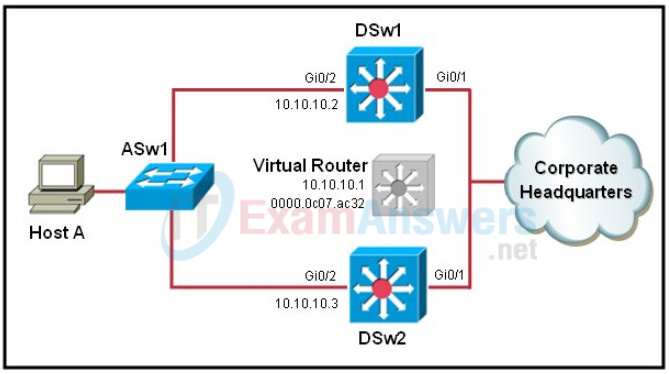
- Applying the standby 32 timers 10 30 command on the Gi0/2 interfaces of each switch would decrease the failover time.
- If the DSw1 and DSw2 switches have been configured to preempt, then DSw2 will be the active router.
- If the DSw1 switch is configured with the standby preempt command and DSw2 is not, then DSw1 will be the active router.
- The HSRP group number in this HSRP configuration is HSRP group number 50.
- The standby track command is useful for tracking interfaces that are not configured for HSRP.
- When host A sends an ARP request for 10.10.10.1, Virtual Router replies with the MAC address of the active router.
15. Refer to the exhibit. What two effects will occur when a fourth distribution module is included in the campus enterprise network that is depicted in the exhibit? (Choose two.)
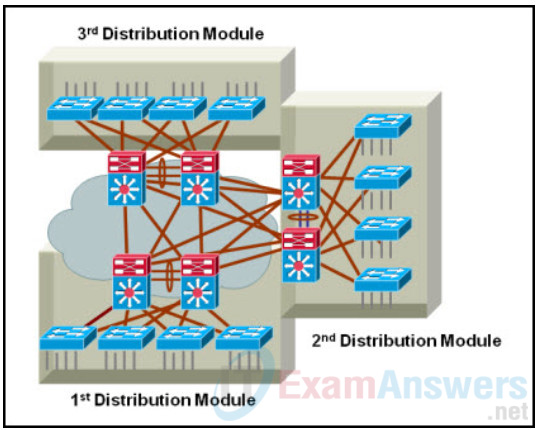
- The inclusion of the fourth module will increase the routing complexity.
- It will limit the traffic flow in the network.
- It will provide scalability for future growth.
- It will impact the security of the traffic between the distribution switches.
- It will increase the number of additional links that are required to provide redundant connectivity.
16. Which two types of access control lists operate at both Layer 2 and Layer 3 of the OSI model? (Choose two.)
- an Ethertype access control list
- a VLAN access control list (VACL)
- a MAC address filter
- a port access control list (PACL)
- a router access control list (RACL)
- a prefix list
17. Refer to the exhibit. Given that interface Fa3/42 is an active trunk port, what two conclusions can be made based on the displayed output? (Choose two.)
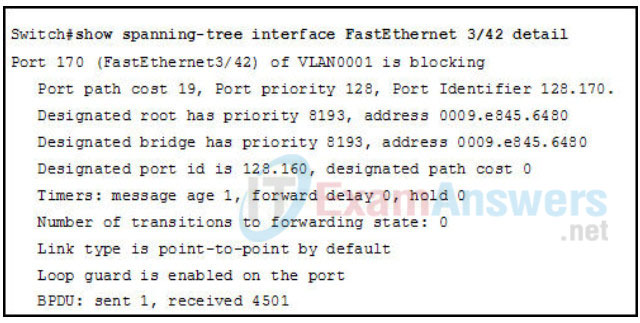
- Root guard is not enabled on interface Fa3/42.
- Interface Fa3/42 will not pass data traffic if it detects that it is part of a spanning-tree loop caused by unidirectional link failure.
- UDLD cannot be configured on interface Fa3/42.
- If a spanning-tree loop is detected on VLAN 1, data traffic will be blocked for all VLANs on interface Fa3/42.
- The difference in BPDUs sent and received indicates a loop caused by unidirectional link failure has been detected.
18. Refer to the exhibit. A network administrator wants to verify the proper operations of the packet load sharing between a group of redundant routers that are configured with GLBP. On the basis of the provided output, which router is the Active Virtual Forwarder (AVF) for Host2?
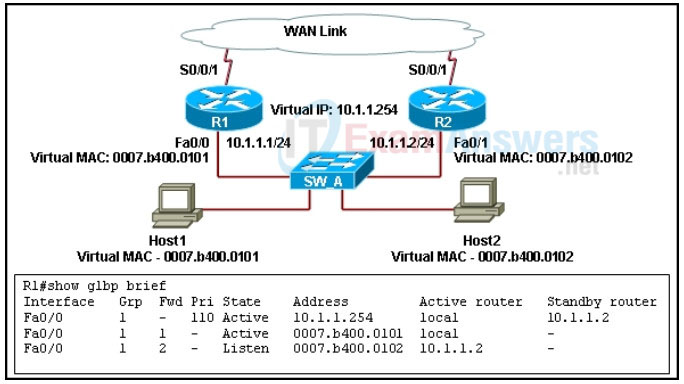
- the router with an IP address of 10.1.1.1
- the router with an IP address of 10.1.1.2
- the router with the virtual IP address of 10.1.1.254
- the router with the IP address 10.1.1.1 and the router with the IP address 10.1.1.2
19. When troubleshooting GLBP in an environment with a VLAN that spans multiple access layer switches, a network engineer discovers that suboptimal paths are being used for upstream traffic. What is the recommended solution?
- Use HSRP instead of GLBP.
- Adjust the GLBP timers.
- Configure spanning tree so that the spanning-tree topology adjusts with the GLBP active virtual forwarder (AVF).
- Disable GLBP preemption on all route processors.
20. Refer to the exhibit. Assuming that the switch is running Multiple Spanning Tree (MST), which conclusion can be made based on the output?

- Spanning-tree load balancing is in effect.
- All VLANs are mapped to MST instance 2.
- PVRST+ is still operating on switch DLS1.
- PVST+ is still operating on switch DLS1.
- MST will require fewer resources than PVST+ or PVRST+.
21. Which two types of attacks can be mitigated by port security? (Choose two.)
- dictionary
- denial of service (DoS)
- replay
- MAC-address flooding
- password
22. With 802.1X port-based authentication, what are the three specific roles for devices? (Choose three.)
- supplicant
- extensible authentication protocol (EAP) server
- authentication server
- authenticatee
- authenticator
- transparent
23. How do Layer 3 switches differ from traditional routers?
- Layer 3 switches are used in LANs. Routers are used in WANs.
- Layer 3 switches use ASICs for routing. Routers are software based.
- Layer 3 switches never perform routing lookups. Routers must always perform them.
- Layer 3 switches forward packets based on MAC addresses only. Routers use IP addresses for forwarding.
24. Refer to the exhibit. What feature does an SNMP manager need to be able to set a parameter on ACSw1?

- a manager who is using an SNMP string of K44p0ut
- a manager who is using an Inform Request MIB
- a manager who is using host 192.168.0.5
- a manager who is using authPriv
25. Refer to the exhibit. Which STP enhancement should be configured in the network to effectively enforce the position of the root bridge?
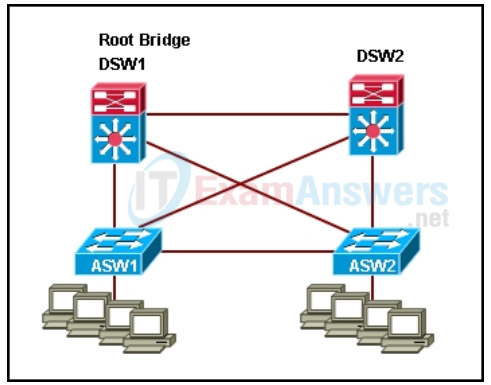
- BPDU guard should be configured on edge ports on the access switches.
- Loop guard should be configured on the link between distribution switches DSW1 and DSW2.
- Root guard should be configured on the distribution switch ports that face the access switches.
- PortFast should be configured on the uplink ports from the access switches to the distribution switches.
26. Refer to the exhibit. What statement is true about the way HSRP is configured?
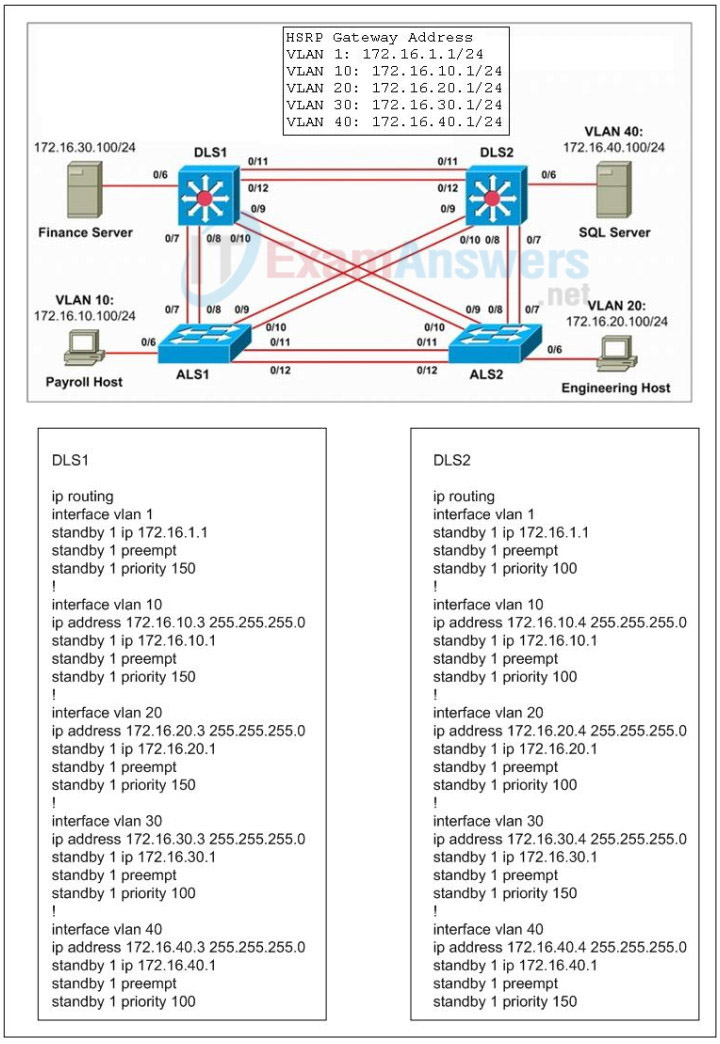
- Switch DLS1 is the standby router for VLANs 1,10, and 20.
- Switch DLS2 is the standby router for VLANs 30 and 40.
- Issuing the show standby command on switch DSL1 will reveal that the HSRP state for VLAN 10 is standby.
- Issuing the show standby command on switch DSL2 will reveal that the HSRP state for VLAN 30 is standby.
- By setting different priorities on different VLANs, a type of load balancing is occurring.
- If the Ethernet cables between switch DLS2 and switch ALS1 were severed, Payroll Host would not be able to reach SQL Server.
27. Which three actions can cause problems with a VTP implementation? (Choose three.)
- using a non-trunk link to connect switches
- using non-Cisco switches
- configuring all switches to be in VTP server mode
- not using any VTP passwords on any switches
- using lowercase on one switch and uppercase on another switch for domain names
- having a VTP transparent switch in between a VTP server switch and a VTP client switch (all switches in the same VTP domain)
28. Which VTP mode is exclusive to VTP version 3?
- Server
- Client
- Transparent
- Off
29. Which three statements about RSTP edge ports are true? (Choose three.)
- Edge ports function similarly to UplinkFast ports.
- Edge ports should never connect to another switch.
- If an edge port receives a BPDU, it becomes a normal spanning-tree port.
- Edge ports immediately transition to learning mode and then forwarding mode when enabled.
- Edge ports never generate topology change notifications (TCNs) when the port transitions to a disabled or enabled status.
- Edge ports can have another switch connected to them as long as the link is operating in full duplex.
30. Refer to the exhibit. What is the problem between the connection on Switch1 and Switch2?
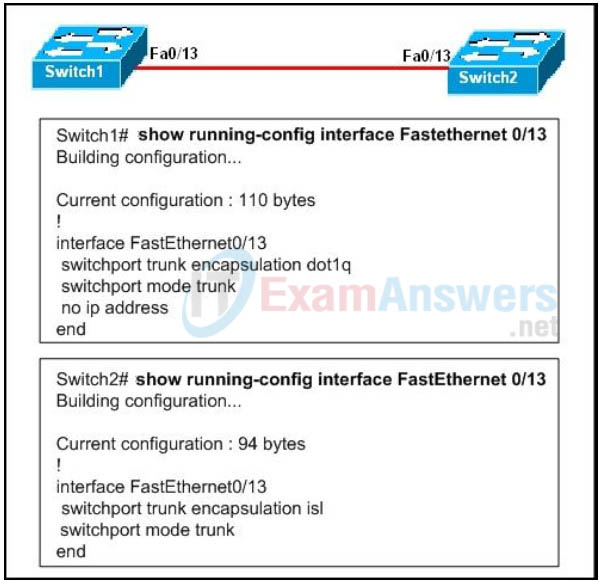
- native VLAN mismatch
- encapsulation mismatch
- switchport mode mismatch
- VTP mismatch
- DTP mismatch
- hardware failure
31. What must be understood about the VRRP master when troubleshooting the Virtual Router Redundancy Protocol (VRRP)?
- The master has the lowest VRRP priority.
- The master has the lowest real IP address.
- The master is not aware of the backup router.
- The preempt option must be enabled on the master.
32. Refer to the exhibit. What happens if interface gigabitEthernet 5/1 on SwitchA stops receiving UDLD packets? (Choose two.)
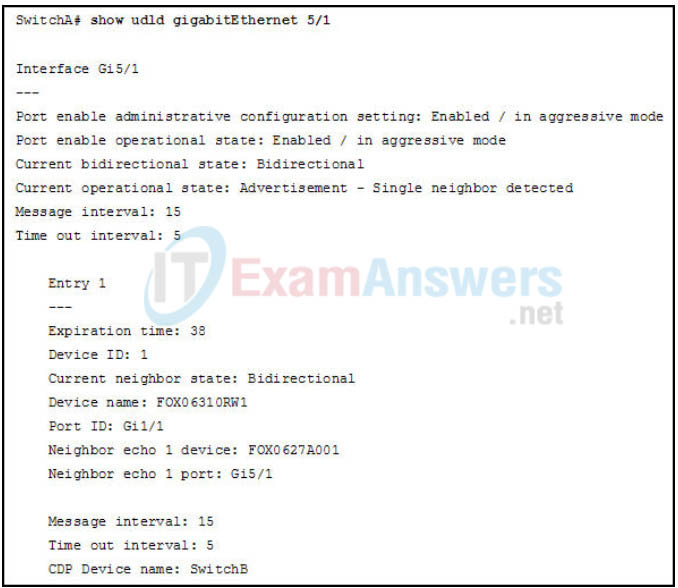
- UDLD stops trying to establish a connection with the neighbor.
- UDLD changes the port state to err-disable.
- UDLD changes the port to loop-inconsistent blocking state.
- UDLD sends messages to its neighbor at a rate of one per second to attempt to recover the connection.
33. Refer to the exhibit. What restriction will be presented in a campus enterprise network that is designed with four large distribution building blocks?
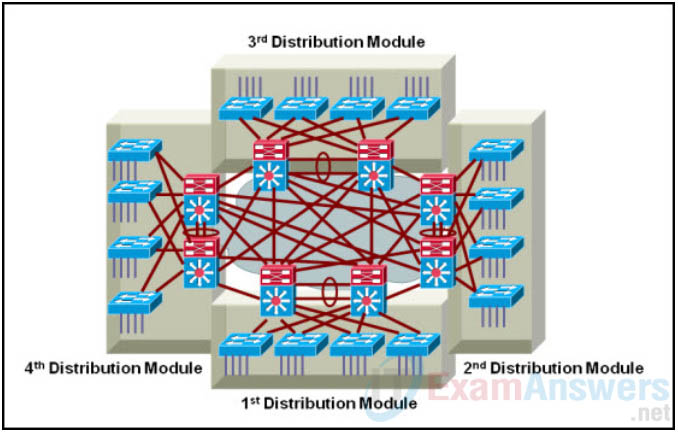
- The implementation of link aggregation will be limited.
- The implementation of IGP routing protocols will be limited.
- The implementation of EtherChannels on redundant links will exceed the bandwidth.
- The implementation of scalability that is required during future growth will be limited.
34. Refer to the exhibit. What two conclusions can be made based on the output? (Choose two.)
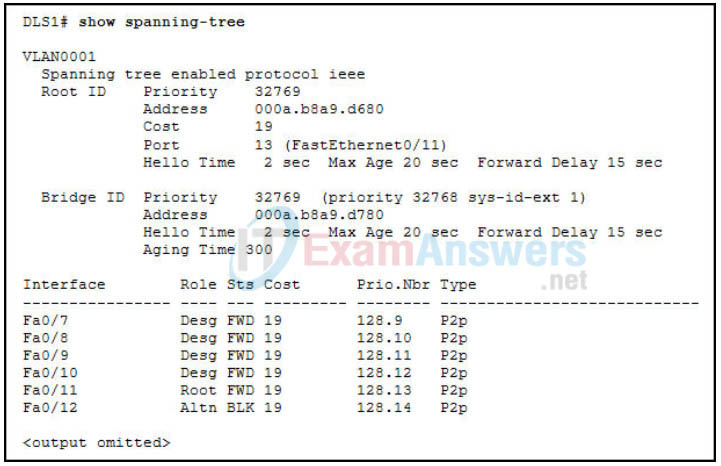
- Interfaces Fa0/1 through Fa0/6 are trunk ports.
- Switch DLS1 is not the root bridge for VLAN 1.
- The Cost column in the lower part of the exhibit is not the cumulative root path cost.
- The default spanning-tree timers have been adjusted.
- That Fa0/12 is displaying the alternate port role indicates that PVRST+ is enabled.
35. What are two benefits of local VLANs in the Enterprise Campus Network? (Choose two.)
- wide coverage because of the fact that a VLAN can be geographically dispersed throughout the network
- finite failure domain because VLANs are local to a switch block
- high availability because redundant paths exist at all infrastructure levels
- broad expansion domain because the number of devices on each VLAN can easily be added to
- IP address conservation because address blocks can be allocated to VLANs
36. Refer to the exhibit. The indicated configuration was established on the HSRP standby router RTB. However, the console message %IP-4-DUPADDR started appearing almost immediately on the RTB router. Given the output of the show standby brief command on RTA, what is the cause of the problem?
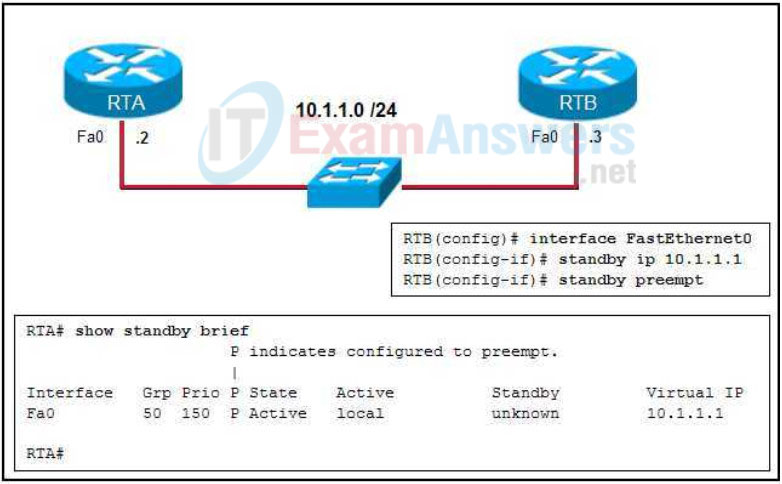
- The subnet mask is missing from the standby ip 10.1.1.1 command.
- The group number 50 is missing in the Router RTB configuration commands.
- The priority number 150 is missing in the Router RTB configuration commands.
- The virtual IP address should be the same as the active router.
- The ports on the switch must be configured with the spanning-tree PortFast feature.
37. Which two items are recommended when mapping local VLANs in an Campus Enterprise Architecture? (Choose two.)
- Associate a VLAN to each building.
- Associate a VLAN to each department.
- Associate a VLAN to each subnet.
- Configure routing between VLANs at the access layer.
- Configure routing between VLANs at the distribution layer.
- Configure routing between VLANs at the core layer.
38. Which dhcp option can be configured to ensure that the IP address of the TFTP server is provided to an IP phone?
- Option 43
- Option 150
- Option 69
- Option 70
39. Refer to the exhibit. What is the result of the displayed configuration on switches ASW1 and ASW2?
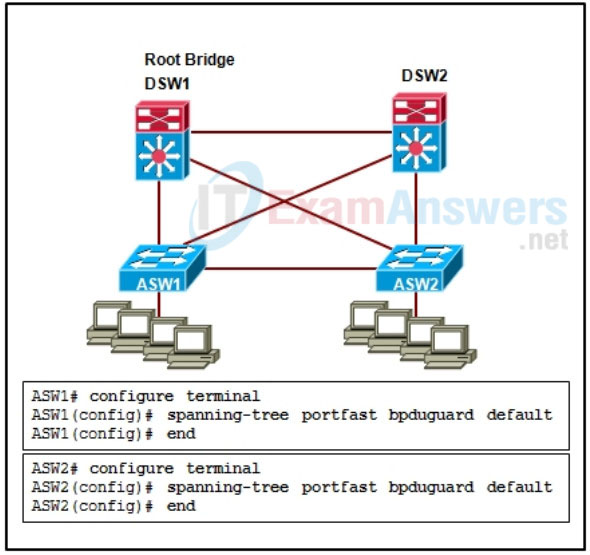
- BPDU guard puts an interface that is configured for STP PortFast in the err-disable state upon receipt of a BPDU.
- BPDU guard overrides the PortFast configuration and reverts to the default spanning tree configuration on the access ports.
- BPDU guard forces the uplink ports on ASW1 and ASW2 to become designated ports to prevent DSW2 from becoming a root switch.
- BPDU guard places the uplink ports on a ASW1 and ASW2 into the STP loop-inconsistent blocking state when the ports stop receiving
BPDUs.
40. When a port security violation occurs on a switch port, the switch sends a syslog message but does not shut down the port. What port security mode is in effect?
- sticky
- shutdown
- restrict
- protect
41. What is the most common method of configuring inter-VLAN routing on a Layer 3 switch?
- Configure the switch physical interface so that the router will have an interface in each VLAN.
- For each VLAN, configure trunking between the router and the switch.
- Configure a routing protocol on the Layer 3 switch to include each interface.
- Configure switch virtual interfaces. The result is that the router will have a virtual interface in each VLAN.
42. The company’s switch network was updated to use VTP Version 3 for VLANs a week ago, and everything seemed to be working fine. Yesterday you were asked to deploy two new VLANs to support new environmental control systems being installed in the building. You configured VLAN 1433 and VLAN 500 on the primary server and left the port-assignments to junior admins as the systems were installed. Today one of the admins reported that they were unable to assign any interfaces on switch XFL1778 to VLAN 1433, and that the switch was reporting that the VLAN does not exist. After further investigation, they reported that they were able to assign an interface on XFL1778 to VLAN 500 with no issues.
What is the most likely problem?
- Switch XFL1778 never got upgraded to VTP version 3
- Switch XFL1778 has the wrong VTP password
- Switch XFL1778 needs to be in transparent mode to support extended range VLANs
- Switch XFL1778 probably does not support extended range VLANs
43. Which STP enhancement should be configured in the network to prevent a nondesignated port to transition to a forwarding state when a topology change occurs?

- Root guard should be implemented on the Layer 2 ports between the distribution switches.
- PortFast should be implemented on the uplink ports from the access switches to the distribution switches.
- Loop guard should be implemented on the Layer 2 ports between DSW1 and DSW2 and on the uplink ports from the access switches to the distribution switches.
- BPDU guard should be implemented on the Layer 2 ports between DSW1 and DSW2 and on the uplink ports from the access switches to the distribution switches.
44. What three features are provided by IEEE 802.1Q trunking? (Choose three.)
- security
- resilience
- QoS support
- multivendor support
- relatively small frame overhead
- multicast support
45. Which three actions are permitted with a VLAN access control list (VACL)? (Choose three.)
- drop
- permit
- capture
- suspend
- restrict
- redirect
46. A bridging loop occurs in a network and disrupts user connectivity. What action should be taken by a network administrator to restore connectivity?
- Disable ports that should be in the blocking state.
- Disable ports that should be in the forwarding state.
- Disable and re-enable all ports on the distribution switches.
- Disable all ports on the distribution switches and replace with new switches.
47. Refer to the exhibit. What configuration will be required on the DSW switch in order to perform inter-VLAN routing for all VLANs that are configured on the access switches?
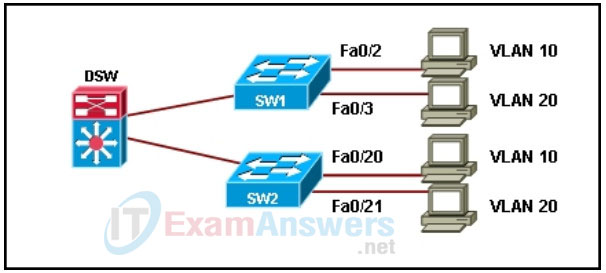
- Configure the routing protocol.
- Configure SVI for each VLAN in the network.
- Configure the links between DSW and the access switches as access links.
- Configure as routed ports the DSW interfaces that face the access switches.
48. Which three parameters must be configured in order to enable SSH? (Choose three.)
- retries
- hostname
- timeouts
- domain name
- keys
- routing protocol
49. Refer to the exhibit. What additional configuration is required in order for users in VLAN 10 to communicate with the users in VLAN 20?
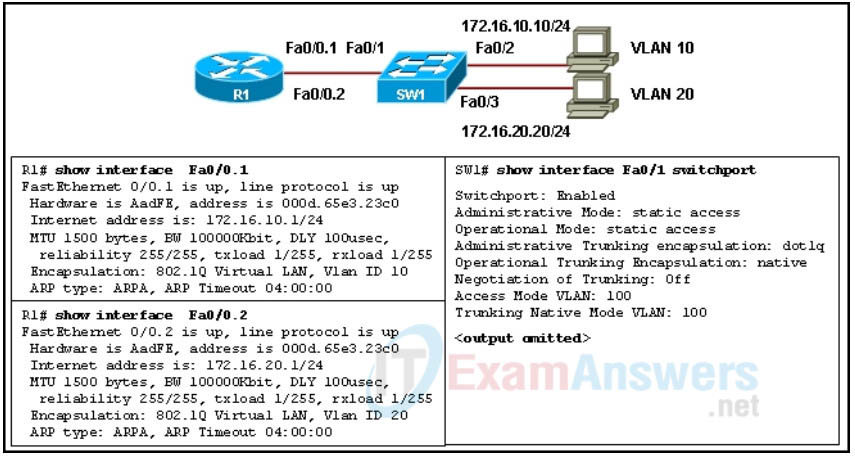
- Configure interface Fa0/1 on SW1 as a trunk.
- Remove the subinterfaces on R1 and configure interface Fa0/0 as a trunk.
- Configure interfaces Fa0/2 and Fa0/3 on SW1 as trunk links.
- Configure VLAN 100 as a data VLAN and VLAN 1 as the native VLAN.
50. Which two statements are true about the default operation of STP in a Layer 2 switched environment that has redundant connections between switches? (Choose two.)
- The root switch is the switch with the highest speed ports.
- Decisions on which port to block when two ports have equal cost depend on the port priority and index.
- All trunking ports are designated and not blocked.
- Root switches have all ports set as root ports.
- Nonroot switches each have only one root port.
51. Which statement correctly explains the process of mitigating ARP attacks on a switch where dynamic ARP inspection (DAI) has been configured?
- All intercepted packets that come from untrusted ports are dropped.
- All intercepted packets that come from trusted ports are sent to untrusted ports only.
- The intercepted packets are verified against the DHCP snooping binding table for valid IP-to-MAC bindings.
- For all intercepted packets, an ARP request is sent to the DHCP server for IP-to-MAC address resolution.
52. Which QoS requirement should be taken into account when implementing VoIP in a campus environment?
- The QoS requirements should accommodate the best effort delivery for voice traffic.
- The QoS requirements should accommodate the bursty nature of voice traffic.
- The QoS requirements should accommodate the intensive demand on bandwidth for voice traffic.
- The QoS requirements should accommodate the smooth demand on bandwidth, low latency, and delay for voice traffic.
53. How should a switch port be configured for a connection to a standalone wireless access point that provides multiple VLAN-separated SSIDs?
- as a trunk port
- as a routed port
- as an access port
- as a switched virtual interface
54. Which two procedures should be implemented and in place when deploying VoIP in a campus network? (Choose two.)
- Keep voice and data traffic in the same VLAN and mark the traffic for high priority treatment.
- Create voice VLANs to keep voice traffic separate from other data to ensure special handling of the traffic.
- Configure traffic shaping QoS policy to guarantee minimum delay for the voice traffic.
- Configure QoS policy to classify the voice traffic in the priority queue to guarantee reserved bandwidth allocation for the traffic.
- Configure the Weighted Random Early Detection (WRED) congestion avoidance mechanism to guarantee that the voice traffic will be placed in the priority queue.
55. What are three possible misconfigurations or indicators of misconfigurations on a Layer 3 interface? (Choose three.)
- wrong IP address or subnet mask
- ports in the wrong VLAN
- mismatch between SVI and VLAN numbering
- disabled VTP pruning
- downed SVI
- ACL on wrong interface
56. What type of queuing provides the best quality for voice applications?
- custom queuing
- FIFO queuing
- priority queuing
- weighted round robin (WRR) queuing
57. Refer to the exhibit. The exhibit contains the configuration for a Cisco access device. How will someone dialing in be authenticated?
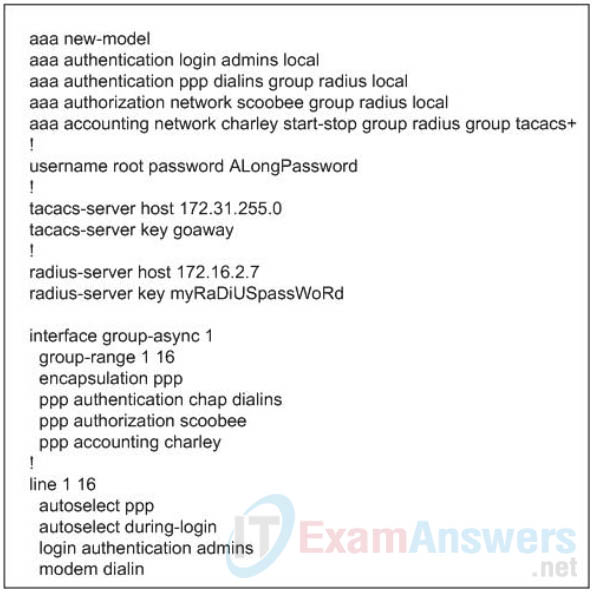
- local username and password
- TACACS+ server
- RADIUS server and, if that fails, local username and password
- TACACS+ server
- TACACS+ server and, if that fails, local username and password
- RADIUS server and, if that fails, TACACS+ server
58. What are two actions a hacker may take in a VLAN hopping attack? (Choose two.)
- replying to ARP requests that are intended for other recipients
- sending malicious dynamic trunking protocol (DTP) frames
- replying to DHCP requests that are intended for a DHCP server
- sending a unicast flood of Ethernet frames with distinct source MAC addresses
- sending frames with two 802.1Q headers
59. A network administrator wants to implement inter-VLAN routing in the network. Which interfaces should be configured as routed ports?
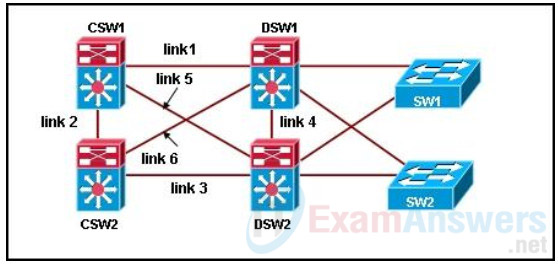
- all interfaces on links 5 and 6
- all interfaces on links 1, 2, 3, and 4
- all interfaces on links 1, 2, 3, 4, 5, and 6
- all interfaces between the distribution and the access switches
60. What is the recommended maximum one-way jitter when implementing video over IP for real-time video applications?
- 1 ms
- 2 ms
- 5 ms
- 10 ms
61. Catalyst Catalyst 6500 switches support which three Supervisor Engine redundancy features? (Choose three.)
- Route Processor Redundancy+ (RPR+)
- distributed CEF (dCEF)
- Stateful Switchover (SSO)
- Resilient Packet Ring (RPR)
- Nonstop Forwarding (NSF)
- Per Line Card Traffic Policing
62. Which benefit is provided by centralizing servers in a data center server farm?
- It keeps client-to-server traffic local to a single subnet.
- Servers that are located in a data center require less bandwidth.
- It is easier to filter and prioritize traffic to and from the data center.
- Server farms are not subject to denial of service attacks.
63. Which three issues can cause devices to become disconnected across a trunk link? (Choose three.)
- native VLAN mismatch
- unassigned management VLAN
- Layer 2 interface mode incompatibilities
- missing default VLAN
- mismatched trunk encapsulations
- PAgP not enabled
64. Which architecture enables enterprises to offer important network services, such as security, new communication services, and improved application performance to every office, regardless of its size or proximity to headquarters?
- Cisco Enterprise Campus Architecture
- Cisco Enterprise Data Center Architecture
- Cisco Enterprise Branch Architecture
- Cisco Enterprise Teleworker Architecture
65. The TCAM defines three different match options that correlate to which three specific match regions? (Choose three.)
- bifurcated match
- longest match
- second match
- exact match
- first match
- third match
66. How do FlexLink and STP operate together?
- If an active STP port is blocked, the active FlexLink port will take over.
- Both the active STP port and active FlexLink port can forward traffic simultaneously.
- Both the active STP port and active FlexLink port can forward traffic simultaneously but only for different VLANs.
- STP can be active in the distribution layer, but is unaware of any FlexLink updates in the access layer.
67. When should a proactive management be performed within the stages of the Cisco Lifecycle Services?
- prepare phase
- plan phase
- design phase
- implement phase
- operate phase
- optimize phase
68. What is required for SLA to capture one-way delays?
- two IP SLA responders
- a Round Trip Timer value
- Network Time Protocol (NTP)
- IP SLA source using TCP port 2020
69. What is the purpose of the debug condition standby vlan vlan-id group-number command in troubleshooting HSRP?
- redirect the debug standby output for the referenced HSRP group to a syslog server on the specified VLAN
- block the debug standby output for the referenced VLAN and HSRP group
- display debug standby output only for HSRP traffic that is received by HSRP peers in the specified VLAN and group
- display debug standby output only for HSRP traffic that is sent to HSRP peers in the specified VLAN and group
- limit the output of the debug standby command to the specific VLAN interface and HSRP group
70. Which phase of the Cisco Lifecycle Services approach includes building a network according to the design and verifying that it performs according to specifications?
- prepare phase
- plan phase
- design phase
- implement phase
71. Refer to the exhibit. The link between switch SW1 and SW2 is manually configured as full duplex on SW2 and with half duplex on SW1. How could this impact the STP operations?
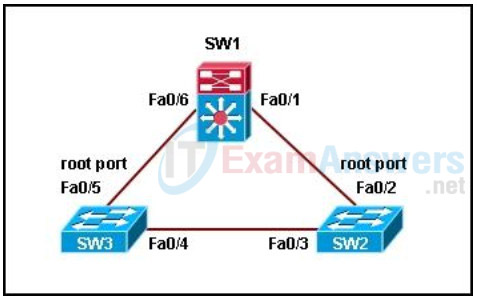
- Switch SW2 can move port Fa0/3 into a forwarding state, thereby creating a Layer 2 loop.
- Switch SW1 shuts down the Fa0/1 port and thus reinforces a new spanning-tree calculation.
- Switch SW2 negotiates the Fa0/1 port on SW1 to be in full-duplex mode which keeps SW1 as the root bridge for the spanning tree.
- Switch SW1 negotiates the Fa0/2 port on SW2 to be in half-duplex mode and thus forces SW2 to become the root bridge for the spanning tree.
72. What is the most fundamental form of high availability when using Catalyst modular switches?
- Spanning Tree Protocol
- routing protocol
- First Hop Redundancy Protocol (FHRP)
- Supervisor Engine redundancy
- redundant switching modules
73. What is the recommended maximum one-way latency when implementing video over IP for real-time video applications?
- Latency is not a factor for a smooth video over IP implementation.
- Latency should be defined for voice traffic only (not for video).
- The recommended maximum one-way latency should not be more than 150 ms.
- When mixed video and voice packets are included in the video stream, the latency should be 300 ms.

Refer to the exhibit. Switch ASW1 has an uplink port that is directly connected to DSW1, a distribution-layer switch. What additional configuration should be provided in order to prevent an ARP attack to the network?
Select one:
Right answer:
Port Fa0/14 should be configured as a trusted port.
Wrong
Port Fa0/14 should be configured with port security.
Port Fa0/14 should be configured as an untrusted port.
VLAN 1 should be configured as the native VLAN for the trunk.
Refer to the exhibit. What two conclusions can be made based on the displayed output? (Choose two.)
Select one or more:
Devices on both sides of the link are receiving UDLD packets.
UDLD puts interface gigabitEthernet 5/1 in err-disable state if it stops receiving UDLD packets.
On which three values is TCAM matching based?
answer
0, 1, and x where x is either 0 or 1
While examining the status of your switch, you find an interface that is has been error-disabled. This particular interface is configured for port security. What is the default method for recovering this interface?
Select one:
Answer
Issue the SHUT and then the NO SHUT commands